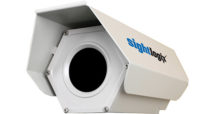As the old adage says, “Necessity is the mother of invention,” and there may be few areas where this is more applicable than in video surveillance. Camera manufacturers’ constant and continuing “resolution race” is creating larger video file sizes that can place significant burdens on bandwidth and storage requirements. Transferring these larger files requires end users to make larger investments in solutions, which drives up overall video system costs — often substantially.
The necessity in this case is the need to reduce these costs and make high-quality video affordable to a wider customer base. This need has borne the invention of a variety of compression technologies designed to reduce file sizes while retaining the quality images users expect from their cameras.
In the security industry today, there are four main compression formats: M-JPEG, MPEG-4, H.264 (also known as MPEG-4 Part 10/AVC) and the “new kid in town,” H.265 (the full name of which is High Efficiency Video Encoding, or HEVC for short). Of these, H.264 remains far and away the most common and most widely used for surveillance applications. And while there is a lot of buzz around the up-and-coming H.265, the reigning champion isn’t likely to give up its title anytime soon, says Brad Donaldson, vice president, product development, Arecont Vision, Glendale, Calif.
“Over the next 12 to 18 months we will likely see some adoption of H.265; however, I believe H.264 will still be more widely used over the next few years,” he says.
In addition to H.264’s demonstrated performance in reducing file sizes since the first incarnation of the standard was approved in 2003, its continued popularity is largely based on its foothold among manufacturers. But James Marcella, director of technical services, Axis Communications, Chelmsford, Mass., offers a more upbeat outlook on H.265’s potential rise.
“The vast majority of camera manufacturers support it as does the rest of the surveillance ecosystem including the VMS and analytics community,” he says. “H.265 is currently a niche offering from a few companies but will replace H.264 over the next 12 to 18 months.”
The ongoing development of higher and higher megapixel cameras has obviously created challenges with bandwidth and storage requirements for the larger video file sizes that are generated. H.264 certainly helps, but there is still a real need for more efficient compression, which H.265 promises to deliver. But given the conversation over the last couple years about its potential to solve these problems, why hasn’t H.265 been adopted on a wider scale yet? According to Marcella, it comes down to a number of issues, including licensing and royalty fees and a lack of support for the new format across the entire surveillance ecosystem.
In terms of H.265’s use in the products that make up surveillance systems, manufacturers have taken the lead, while software and other providers have lagged behind, which has presented another stumbling block for adoption.
“Camera manufacturers have started to release cameras that have H.264 and H.265 capabilities; however, the VMS companies are slower to react, with only a few so far that have released software versions that can use H.265 cameras,” says Chris Olson, director of engineering, Intertech Ci, Pittsburgh. “The VMS companies will lag camera companies for adoption as it requires a fair amount of work and testing on their end; the VMS companies want to see a broader camera commitment.”
INTERIM SOLUTIONS
While the industry continues to anticipate the rise of H.265, some manufacturers have focused their energy on developing more powerful versions of H.264 in the interim.
“Camera manufacturers have created ‘super’ H.264 solutions that dynamically change camera settings based on the scene to reduce bandwidth and storage,” Olson says. “Examples of two companies that have done this are Axis with its Zipstream cameras and Hikvision and its H.264+ Smart Codec System.”
These smart codecs are designed to apply compression differently based on factors within the field of view, which helps H.264 to deliver bandwidth and savings that are at least on par with H.265.
“Many camera manufacturers have come out with, and are continuing to come out with ‘smart’ H.264 codecs that allow for applying heavier compression to areas where there is less activity,” he says. “Some smart codecs also allow for dynamic GOP sizes and dynamic frame rate adjustment, which further reduces the storage and bandwidth requirements.”
While these tweaked versions of H.264 are helpful in the meantime, David Choi, product manager, Speco Technologies, Amityville, N.Y., says that like H.265, they fall outside of the standardized set of formats.
Efforts to create an accepted H.265 standard are underway but have not yet been released.
On the storage provider front, those companies are for the most part taking a “wait and see” approach to H.265 because of the extremely limited product availability at the moment, says Tom Larson, director of sales and engineering for Northbrook, Ill.-based BCDVideo.
“After the camera and VMS guys bring product to market, then we will start testing to see what the impact will be on the hardware as far as CPU load and disk storage to determine how many cameras and total bandwidth per server,” he says. “Since H.265 cameras are not mainstream yet, we have not done any of this testing.”
THEORY VS. REALITY
Perhaps the biggest potential hurdle to adoption is the perception that H.265 simply isn’t developed enough to be a realistic option for video compression. One issue lies in the codec’s ability to live up to the bandwidth and storage reduction claims that have been made, which Michael Sherwood, manager, professional services, Milestone Systems Americas, Beaverton, Ore., says is nothing new.
“Like H.264 when it was first released, H.265 is not currently showing a large improvement in storage and bandwidth but will very likely increase as the codec is further optimized,” he says.
However, those who tout the potential efficiency gains and cost savings from using H.265 are not necessarily being dishonest. The problem, says Brandon Reich, senior director of surveillance solutions, Pivot3, Austin, Texas, lies in the difference between theory and reality.
“H.265’s biggest claim is a 40 to 50 percent bandwidth reduction and some storage reduction, and that is probably going to happen with static images, ideal conditions, and continuous recording; but that is not real world,” he says. “The real world is image complexity and motion. In those cases, H.265 can lead to bigger spikes in bandwidth.”
Despite these challenges, H.265 will continue to make gains toward delivering on its potential, says Fredrik Svensson, who chairs ONVIF’s Profile T Working Group.
“It’s ready for prime time, but it is also somewhat of a work in progress in the physical security industry,” he says. “Ideally there would be support for your desired specific compression format in all parts of your physical security system — the VMS, server hardware, graphics cards and camera. It does take a while for all of these components to be ready. But it’s only a matter of time for widespread H.265 adoption.”
KNOW YOUR COMPRESSION
In general, Donaldson says, there are three camera parameters integrators must fully understand to properly deploy systems with the appropriate compression: frame rate, bit rate and image quality. Knowing these parameters and how they interact with each other is essential to calculating storage and meeting end users’ expectations, he adds.
“Adjustment for image quality will directly impact the level of compression while adjustment to bit rate and frame rate settings can indirectly impact the level of compression, depending on how the system is configured,” he says.
Of course, the first consideration — as always — must be the objectives behind each camera’s role in an installation, which will guide integrators toward choosing the compression format or technology that is best suited for the system as a whole.
“The ultimate goal is not to simply provide video coverage with the least bandwidth, storage or expense but rather to meet the customer’s needs so when the video is required it is readily accessible and of use for their given circumstance,” Sherwood says.
For those security professionals who ultimately determine that H.265 is the way to go, there are additional considerations that go along with that format, including substantially greater computing and processing requirements and impacts.
“Infrastructure requirements will increase,” Reich says. “Smart codecs can help mitigate some of that, but it will not eliminate it.”
In many cases, integrators can look to how another industry has traditionally dealt with these same types of challenges.
“It’s time to take cues from IT,” Reich says.” Be familiar with shared storage and computer resources, advanced resiliency and fault tolerance, mobility — these can reduce costs, improve reliability and bring real benefits to end users.”
It’s also important to consider that there may be other tactics or practices for reducing bandwidth in addition to — or instead of — technology.
“I always preferred connecting cameras to a private network switch directly on the recorder utilizing the secondary NIC,” says Adam Deegan, application engineer, Northland Control Systems, Fremont, Calif., and a member of PSA Security Network’s Technical Committee. “This allows [for a] security managed network and does not use up bandwidth to the building network.”
Because planning is key to any successful installation, integrators should have a firm grasp on network requirements and map out the infrastructure before installing anything, Choi says.
“Figure out the total amount of bandwidth and storage that is needed before installing the wiring and equipment,” he says. “As camera resolutions get higher, the storage and bandwidth gets higher as well, so that image quality is kept.”
A final piece of advice is to know with whom or what the video surveillance system may share the network and to collaborate with any additional stakeholders, says Christopher Wetzel, founder and executive vice president, Intertech Ci.
“One thing to keep in mind is if the surveillance system is located on a shared network and security is not in total control of the network, other systems can have a huge impact of the performance of the system from one day to the next. So it’s important to develop a positive relationship with IT,” he says.
For all its promise, it’s important to remember that H.265 is just the latest in a long line of compression formats driven by higher resolution. Therefore, it is not the be-all, end-all solution for reducing video file sizes, and others will certainly follow. Because most of these compression formats have transitioned to security from the consumer industry, Marcella suggests integrators keep an eye on that space to anticipate and better prepare for new technologies.
“There will always be a new compression format on the horizon. Keep your eye on the consumer electronics market for advances that will ultimately get repurposed into security products,” Marcella says.
JPEG and MPEG-4 In Depth
Simply knowing that there are four main video compression formats is not enough; integrators must have a more complete understanding of the ins, outs, pros and cons of each. The majority of security professionals have a fairly firm grasp on H.264 and to some extent H.265. However, while JPEG and MPEG-4 both remain viable options, they may be less understood. To help further integrators’ overall knowledge and expertise in the video compression arena, James Marcella of Axis Communications provided this in-depth look at the two lesser-known formats:
“JPEG provides the least amount of bandwidth and storage reduction and has been widely replaced by the other compression formats listed. JPEG compression removes redundant data in the image and sends individual “frames or images” in succession to provide motion video. Each frame contains all the relevant information from the last; as a result, JPEG recordings require considerably more bandwidth and storage compared with other compression techniques.
“MPEG-4 provides considerable bandwidth and storage savings over JPEG and is still used by some DVR manufacturers. It has been widely replaced by H.264 in most surveillance recording platforms. MPEG4 is a true video compression format that not only removes redundant data in an image but also only transmits the changes from one image to another.”
Gazing Into the Crystal Ball
Without a doubt, there is widespread agreement within the industry that H.265 offers tremendous potential to reduce bandwidth and storage requirements to make 4K and other higher-megapixel formats more cost-effective for a wider range of end users. At present, however, the conversation remains largely about potential, rather than performance, as few manufacturers have released solutions that incorporate H.265 capability.
To get some insight into just when H.265 might be fully “ready for prime time,” SDM asked several manufacturers and integrators to weigh in.
David Choi, Speco Technologies: “In the next year or two, it’ll be a battle between H.265 and smart H.264. Smart H.264 aims to take the standard H.264 compression and compress the video more in parts of the image where there may not be as much motion and action. H.265 compresses more of the entire image than H.264, leading to less bandwidth and storage.”
Chris Olson, Intertech Ci: “It doesn’t look like 2016 is going to be the year for widespread H.265 adoption. Until you test it with a VMS system, you won’t know how well a camera performs or its full functionality.”
Chris Peckham, Kratos Public Safety and Security: “CPU power has been holding some deployments up and will be addressed as endpoints and servers are upgraded. Licensing and royalty rates were also a concern for some users that needed to be addressed by vendors in the supply chain. As time moves forward, the newer formats will be seen in wider deployments.”
Brandon Reich, Pivot3: “It will take time for H.265 to be widely adopted just like it took time for standards such as ONVIF get established and become the norm. H.265 is ready, and it does help with bandwidth and storage in particular conditions, but it is not optimized yet. It will take time for manufacturers to refine their particular optimization and benefit from all the efficiency.”
Michael Sherwood, Milestone Systems Americas: “Over the next 12 to 18 months, smart H.264 codecs are likely to continue being released and improved while H.265 will likely start to become more commonplace.”
Fredrik Svensson, ONVIF: “In the next year, it’s likely that H.265, H.264’s successor, will be increasingly used for compression…. Some companies are already using H.265 in their cameras and video management systems. Manufacturers are certainly preparing for its broader adoption in the coming year.”
Christopher Wetzel, Intertech Ci: “We have for some time been anticipating H.265, but this has been slow to adopt because many manufacturers do not feel the standard has been finalized yet. A lot of times manufacturers want to wait and see where the standard is before they make changes in the products because of the cost of R&D. Many companies are going to make sure the standards have been set before they make that investment.”
Setting a Standard
One of the knocks against H.265 is that there is no widely accepted standard for the codec within the security industry. But help is on the way, as the International Telecommunication Union (ITU), the Moving Picture Experts Group (MPEG), a joint commission of the International Organization for Standardization (ISO) and the International Electrotechnical Commission (IEC) and others are working to change this reality.
While security standards-setting organization ONVIF isn’t directly involved in these efforts, Fredrik Svensson, chair of ONVIF’s Profile T Working Group, shares insight into how the organization is addressing H.265:
“ONVIF is working to incorporate into its specifications the use of new formats such as H.265, but is not directly involved in developing the compression standards themselves. With Profile T, which is the new ONVIF video profile that is currently being developed, ONVIF will use a new media service that is compression agnostic. This means that it can support new video compression formats, including H.265, and new audio compression formats as well, including new formats added in the future. ONVIF will be able to add both video and audio codecs as needed without having to redesign its media service.
“ONVIF is including support for H.265 in Profile T because it will become the most widely used compression format and ONVIF wants to anticipate that migration, as well as the future needs of the industry.”
Advice for Integrators, from Integrators
While information from manufacturers can be helpful for integrators, the best advice is that which comes from their peers. To that end, SDM asked three integrators to share their insights on compression with fellow integrators.
Adam Deegan, Northland Control Systems: “Integrators need to know compression requires finding the best balance of image quality and bit rate reduction.”
Chris Olson, Intertech Ci: “The principles of how compression works and the tradeoffs that affect bandwidth and storage are not always clearly understood by integrators. The default settings are typically used, but a good understanding of how compression settings can be changed can help integrators improve the performance and quality of the system they are installing.”
Chris Peckham, Kratos Public Safety and Security: “Integrators need to keep up with the details of the technology as things change, and be able to discuss as needed for sales, installation and support work with the end user. These changes can add some additional levels of complexity to be understood for a successful design and implementation.”









